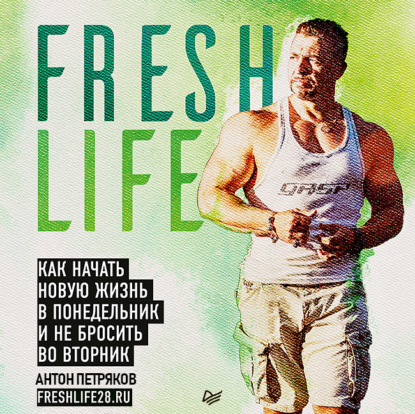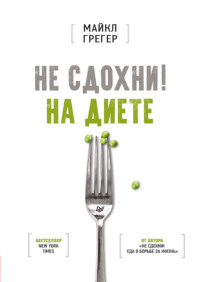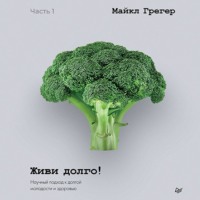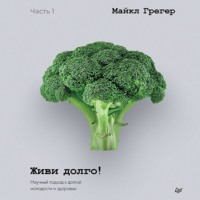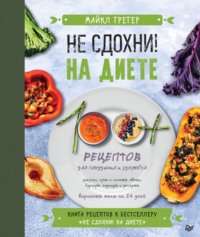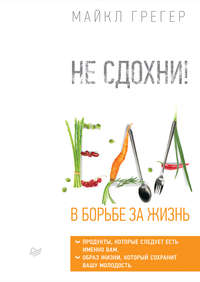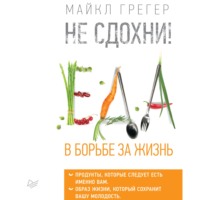
Полная версия
Живи долго! Научный подход к долгой молодости и здоровью
873
Sutter NB, Bustamante CD, Chase K, et al. A single IGF1 allele is a major determinant of small size in dogs. Science. 2007;316(5821):112–5. https://pubmed.ncbi.nlm.nih.gov/17412960/
874
Samaras TT. How height is related to our health and longevity: a review. Nutr Health. 2012;21(4):247–61. https://pubmed.ncbi.nlm.nih.gov/24620006/
875
Sohn K. Now, the taller die earlier: the curse of cancer. J Gerontol A Biol Sci Med Sci. 2016;71(6):713–9. https://pubmed.ncbi.nlm.nih.gov/25991828/
876
Samaras TT. How height is related to our health and longevity: a review. Nutr Health. 2012;21(4):247–61. https://pubmed.ncbi.nlm.nih.gov/24620006/
877
Samaras TT, Elrick H, Storms LH. Is height related to longevity? Life Sci. 2003;72(16):1781–802. https://pubmed.ncbi.nlm.nih.gov/12586217/
878
Samaras TT. How height is related to our health and longevity: a review. Nutr Health. 2012;21(4):247–61. https://pubmed.ncbi.nlm.nih.gov/24620006/
879
Один дюйм равен 2,54 см. – Примеч. ред.
880
Sohn K. Now, the taller die earlier: the curse of cancer. J Gerontol A Biol Sci Med Sci. 2016;71(6):713–9. https://pubmed.ncbi.nlm.nih.gov/25991828/
881
Walter RB, Brasky TM, Buckley SA, Potter JD, White E. Height as an explanatory factor for sex differences in human cancer. J Natl Cancer Inst. 2013;105(12):860–8. https://pubmed.ncbi.nlm.nih.gov/23708052/
882
Shors AR, Solomon C, McTiernan A, White E. Melanoma risk in relation to height, weight, and exercise (United States). Cancer Causes Control. 2001;12(7):599–606. https://pubmed.ncbi.nlm.nih.gov/11552707/
883
Walter RB, Brasky TM, Buckley SA, Potter JD, White E. Height as an explanatory factor for sex differences in human cancer. J Natl Cancer Inst. 2013;105(12):860–8. https://pubmed.ncbi.nlm.nih.gov/23708052/
884
Suh Y, Atzmon G, Cho MO, et al. Functionally significant insulin-like growth factor I receptor mutations in centenarians. Proc Natl Acad Sci U S A. 2008;105(9):3438–42. https://pubmed.ncbi.nlm.nih.gov/18316725/
885
Reed JC. Dysregulation of apoptosis in cancer. J Clin Oncol. 1999;17(9):2941–53. https://pubmed.ncbi.nlm.nih.gov/10561374/
886
Murphy N, Knuppel A, Papadimitriou N, et al. Insulin-like growth factor-1, insulin-like growth factor-binding protein-3, and breast cancer risk: observational and Mendelian randomization analyses with ~430 000 women. Ann Oncol. 2020;31(5):641–9. https://pubmed.ncbi.nlm.nih.gov/32169310/
887
Chi F, Wu R, Zeng Y, Xing R, Liu Y. Circulation insulin-like growth factor peptides and colorectal cancer risk: an updated systematic review and meta-analysis. Mol Biol Rep. 2013;40(5):3583–90. https://pubmed.ncbi.nlm.nih.gov/23269623/
888
Travis RC, Appleby PN, Martin RM, et al. A meta-analysis of individual participant data reveals an association between circulating levels of IGF-I and prostate cancer risk. Cancer Res. 2016;76(8):2288–300. https://pubmed.ncbi.nlm.nih.gov/26921328/
889
Cao H, Wang G, Meng L, et al. Association between circulating levels of IGF-1 and IGFBP-3 and lung cancer risk: a meta-analysis. PLoS One. 2012;7(11):e49884. https://pubmed.ncbi.nlm.nih.gov/23185474/
890
Li Y, Li Y, Zhang J, et al. Circulating insulin-like growth factor-1 level and ovarian cancer risk. Cell Physiol Biochem. 2016;38(2):589–97. https://pubmed.ncbi.nlm.nih.gov/26845340/
891
Gong Y, Zhang B, Liao Y, et al. Serum insulin-like growth factor axis and the risk of pancreatic cancer: systematic review and meta-analysis. Nutrients. 2017;9(4):394. https://pubmed.ncbi.nlm.nih.gov/28420208/
892
Hankinson SE, Willett WC, Colditz GA, et al. Circulating concentrations of insulin-like growth factor I and risk of breast cancer. Lancet. 1998;351(9113):1393–6. https://pubmed.ncbi.nlm.nih.gov/9593409/
893
Yee D. Insulin-like growth factor receptor inhibitors: baby or the bathwater? J Natl Cancer Inst. 2012;104(13):975–81. https://pubmed.ncbi.nlm.nih.gov/22761272/
894
Quan H, Tang H, Fang L, Bi J, Liu Y, Li H. IGF1(CA)19 and IGFBP-3–202A/C gene polymorphism and cancer risk: a meta-analysis. Cell Biochem Biophys. 2014;69(1):169–78. https://pubmed.ncbi.nlm.nih.gov/24310658/
895
Yokoyama NN, Denmon AP, Uchio EM, Jordan M, Mercola D, Zi X. When anti-aging studies meet cancer chemoprevention: can anti-aging agent kill two birds with one blow? Curr Pharmacol Rep. 2015;1(6):420–33. https://pubmed.ncbi.nlm.nih.gov/26756023/
896
Elia I, Doglioni G, Fendt SM. Metabolic hallmarks of metastasis formation. Trends Cell Biol. 2018;28(8):673–84. https://pubmed.ncbi.nlm.nih.gov/29747903/
897
Kleinberg DL, Wood TL, Furth PA, Lee AV. Growth hormone and insulin-like growth factor-I in the transition from normal mammary development to preneoplastic mammary lesions. Endocr Rev. 2009;30(1):51–74. https://pubmed.ncbi.nlm.nih.gov/19075184/
898
Yang SY, Miah A, Pabari A, Winslet M. Growth factors and their receptors in cancer metastases. Front Biosci (Landmark Ed). 2011;16:531–8. https://pubmed.ncbi.nlm.nih.gov/21196186/
899
Zhang Y, Ma B, Fan Q. Mechanisms of breast cancer bone metastasis. Cancer Lett. 2010;292(1):1–7. https://pubmed.ncbi.nlm.nih.gov/20006425/
900
Yang SY, Miah A, Pabari A, Winslet M. Growth factors and their receptors in cancer metastases. Front Biosci (Landmark Ed). 2011;16:531–8. https://pubmed.ncbi.nlm.nih.gov/21196186/
901
Sohn K. Now, the taller die earlier: the curse of cancer. J Gerontol A Biol Sci Med Sci. 2016;71(6):713–19. https://pubmed.ncbi.nlm.nih.gov/25991828/
902
Salvioli S, Capri M, Bucci L, et al. Why do centenarians escape or postpone cancer? The role of IGF-1, inflammation and p53. Cancer Immunol Immunother. 2009;58(12):1909–17. https://pubmed.ncbi.nlm.nih.gov/19139887/
903
Piantanelli L. Cancer and aging: from the kinetics of biological parameters to the kinetics of cancer incidence and mortality. Ann N Y Acad Sci. 1988;521:99–109. https://pubmed.ncbi.nlm.nih.gov/3377369/
904
Kenyon C. The plasticity of aging: insights from long-lived mutants. Cell. 2005;120(4):449–60. https://pubmed.ncbi.nlm.nih.gov/15734678/
905
Stanta G, Campagner L, Cavallieri F, Giarelli L. Cancer of the oldest old. What we have learned from autopsy studies. Clin Geriatr Med. 1997;13(1):55–68. https://pubmed.ncbi.nlm.nih.gov/8995100/
906
Salvioli S, Capri M, Bucci L, et al. Why do centenarians escape or postpone cancer? The role of IGF-1, inflammation and p53. Cancer Immunol Immunother. 2009;58(12):1909–17. https://pubmed.ncbi.nlm.nih.gov/19139887/
907
Laron Z, Pertzelan A, Mannheimer S. Genetic pituitary dwarfism with high serum concentration of growth hormone: a new inborn error of metabolism? Isr J Med Sci 1966;2:152–5. https://pubmed.ncbi.nlm.nih.gov/5916640/
908
Guevara-Aguirre J, Bautista C, Torres C, et al. Insights from the clinical phenotype of subjects with Laron syndrome in Ecuador. Rev Endocr Metab Disord. 2021;22(1):59–70. https://pubmed.ncbi.nlm.nih.gov/33047268/
909
Laron Z, Kauli R, Lapkina L, Werner H. IGF-I deficiency, longevity and cancer protection of patients with Laron syndrome. Mutat Res Rev Mutat Res. 2017;772:123–33. https://pubmed.ncbi.nlm.nih.gov/28528685/
910
Guevara-Aguirre J, Balasubramanian P, Guevara-Aguirre M, et al. Growth hormone receptor deficiency is associated with a major reduction in pro-aging signaling, cancer, and diabetes in humans. Sci Transl Med. 2011;3(70):70ra13. https://pubmed.ncbi.nlm.nih.gov/21325617/
911
Boguszewski CL, Boguszewski MC da S. Growth hormone’s links to cancer. Endocr Rev. 2019;40(2):558–74. https://pubmed.ncbi.nlm.nih.gov/30500870/
912
Guevara-Aguirre J, Balasubramanian P, Guevara-Aguirre M, et al. Growth hormone receptor deficiency is associated with a major reduction in pro-aging signaling, cancer, and diabetes in humans. Sci Transl Med. 2011;3(70):70ra13. https://pubmed.ncbi.nlm.nih.gov/21325617/
913
Laron Z, Kauli R, Lapkina L, Werner H. IGF-I deficiency, longevity and cancer protection of patients with Laron syndrome. Mutat Res Rev Mutat Res. 2017;772:123–33. https://pubmed.ncbi.nlm.nih.gov/28528685/
914
Ma H, Zhang T, Shen H, Cao H, Du J. The adverse events profile of anti-IGF-1R monoclonal antibodies in cancer therapy. Br J Clin Pharmacol. 2014;77(6):917–28. https://pubmed.ncbi.nlm.nih.gov/24033707/
915
Thissen JP, Ketelslegers JM, Underwood LE. Nutritional regulation of the insulin-like growth factors. Endocr Rev. 1994;15(1):80–101. https://pubmed.ncbi.nlm.nih.gov/8156941/
916
Lee C, Safdie FM, Raffaghello L, et al. Reduced levels of IGF-I mediate differential protection of normal and cancer cells in response to fasting and improve chemotherapeutic index. Cancer Res. 2010;70(4):1564–72. https://pubmed.ncbi.nlm.nih.gov/20145127/
917
Longo VD, Anderson RM. Nutrition, longevity and disease: from molecular mechanisms to interventions. Cell. 2022;185(9):1455–70. https://pubmed.ncbi.nlm.nih.gov/35487190/
918
Dunn SE, Kari FW, French J, et al. Dietary restriction reduces insulin-like growth factor I levels, which modulates apoptosis, cell proliferation, and tumor progression in p53-deficient mice. Cancer Res. 1997;57(21):4667–72. https://pubmed.ncbi.nlm.nih.gov/9354418/
919
Fontana L, Weiss EP, Villareal DT, Klein S, Holloszy JO. Long-term effects of calorie or protein restriction on serum IGF-1 and IGFBP-3 concentration in humans. Aging Cell. 2008;7(5):681–7. https://pubmed.ncbi.nlm.nih.gov/18843793/
920
Schüler R, Markova M, Osterhoff MA, et al. Similar dietary regulation of IGF-1-and IGF-binding proteins by animal and plant protein in subjects with type 2 diabetes. Eur J Nutr. https://link.springer.com/article/10.1007/s00394–021–02518-y. Published online March 8, 2021. Accessed June 23, 2021.; https://pubmed.ncbi.nlm.nih.gov/33686453/
921
Allen NE, Appleby PN, Davey GK, Key TJ. Hormones and diet: low insulin-like growth factor-I but normal bioavailable androgens in vegan men. Br J Cancer. 2000;83(1):95–7. https://pubmed.ncbi.nlm.nih.gov/10883675/
922
Allen NE, Appleby PN, Davey GK, Kaaks R, Rinaldi S, Key TJ. The associations of diet with serum insulin-like growth factor I and its main binding proteins in 292 women meat-eaters, vegetarians, and vegans. Cancer Epidemiol Biomarkers Prev. 2002;11(11):1441–8. https://pubmed.ncbi.nlm.nih.gov/12433724/
923
Ngo TH, Barnard RJ, Tymchuk CN, Cohen P, Aronson WJ. Effect of diet and exercise on serum insulin, IGF-I, and IGFBP-1 levels and growth of LNCaP cells in vitro (United States). Cancer Causes Control. 2002;13(10):929–35. https://pubmed.ncbi.nlm.nih.gov/12588089/
924
Flood A, Mai V, Pfeiffer R, et al. The effects of a high-fruit and – vegetable, high-fiber, low-fat dietary intervention on serum concentrations of insulin, glucose, IGF-I and IGFBP-3. Eur J Clin Nutr. 2008;62(2):186–96. https://pubmed.ncbi.nlm.nih.gov/17487212/
925
Allen NE, Appleby PN, Davey GK, Key TJ. Hormones and diet: low insulin-like growth factor-I but normal bioavailable androgens in vegan men. Br J Cancer. 2000;83(1):95–7. https://pubmed.ncbi.nlm.nih.gov/10883675/
926
Allen NE, Appleby PN, Davey GK, Kaaks R, Rinaldi S, Key TJ. The associations of diet with serum insulin-like growth factor I and its main binding proteins in 292 women meat-eaters, vegetarians, and vegans. Cancer Epidemiol Biomarkers Prev. 2002;11(11):1441–8. https://pubmed.ncbi.nlm.nih.gov/12433724/
927
Berrino F, Bellati C, Secreto G, et al. Reducing bioavailable sex hormones through a comprehensive change in diet: the diet and androgens (DIANA) randomized trial. Cancer Epidemiol Biomarkers Prev. 2001;10(1):25–33. https://pubmed.ncbi.nlm.nih.gov/11205485/
928
Kaaks R, Bellati C, Venturelli E, et al. Effects of dietary intervention on IGF-I and IGF-binding proteins, and related alterations in sex steroid metabolism: the Diet and Androgens (DIANA) Randomised Trial. Eur J Clin Nutr. 2003;57(9):1079–88. https://pubmed.ncbi.nlm.nih.gov/12947426/
929
Pasanisi P, Bruno E, Venturelli E, et al. A dietary intervention to lower serum levels of IGF-I in BRCA mutation carriers. Cancers (Basel). 2018;10(9):309. https://pubmed.ncbi.nlm.nih.gov/30181513/
930
Gulick CN, Peddie MC, Cameron C, Bradbury K, Rehrer NJ. Physical activity, dietary protein and insulin-like growth factor 1: cross-sectional analysis utilising UK Biobank. Growth Horm IGF Res. 2020;55:101353. https://pubmed.ncbi.nlm.nih.gov/33002777/
931
Toden S, Belobrajdic DP, Bird AR, Topping DL, Conlon MA. Effects of dietary beef and chicken with and without high amylose maize starch on blood malondialdehyde, interleukins, IGF-I, insulin, leptin, MMP-2, and TIMP-2 concentrations in rats. Nutr Cancer. 2010;62(4):454–65. https://pubmed.ncbi.nlm.nih.gov/20432166/
932
Qin LQ, He K, Xu JY. Milk consumption and circulating insulin-like growth factor-I level: a systematic literature review. Int J Food Sci Nutr. 2009;60(S7):330–40. https://pubmed.ncbi.nlm.nih.gov/19746296/
933
Один галлон равен 4,55 л. – Примеч. ред.
934
Hoppe C, Kristensen M, Boiesen M, Kudsk J, Michaelsen KF, Mølgaard C. Short-term effects of replacing milk with cola beverages on insulin-like growth factor-I and insulin – glucose metabolism: a 10 d interventional study in young men. Br J Nutr. 2009;102(7):1047–51. https://pubmed.ncbi.nlm.nih.gov/15578035/
935
Harrison S, Lennon R, Holly J, et al. Does milk intake promote prostate cancer initiation or progression via effects on insulin-like growth factors (IGFs)? A systematic review and meta-analysis. Cancer Causes Control. 2017;28(6):497–528. https://pubmed.ncbi.nlm.nih.gov/28361446/
936
Adams AM, Smith AF. Risk perception and communication: recent developments and implications for anaesthesia. Anaesthesia. 2001;56(8):745–55. https://pubmed.ncbi.nlm.nih.gov/11493237/
937
Harrison S, Lennon R, Holly J, et al. Does milk intake promote prostate cancer initiation or progression via effects on insulin-like growth factors (IGFs)? A systematic review and meta-analysis. Cancer Causes Control. 2017;28(6):497–528. https://pubmed.ncbi.nlm.nih.gov/28361446/
938
Naghshi S, Sadeghi O, Larijani B, Esmaillzadeh A. High vs. low-fat dairy and milk differently affects the risk of all-cause, CVD, and cancer death: a systematic review and dose-response meta-analysis of prospective cohort studies. Crit Rev Food Sci Nutr. 2021;Jan 5:1–15. https://pubmed.ncbi.nlm.nih.gov/33397132/
939
Qin LQ, He K, Xu JY. Milk consumption and circulating insulin-like growth factor-I level: a systematic literature review. Int J Food Sci Nutr. 2009;60(7):330–40. https://pubmed.ncbi.nlm.nih.gov/19746296/
940
Jones CM, Heinrichs J. Growth charts for dairy heifers. Penn State Extension. https://extension.psu.edu/growth-charts-for-dairy-heifers. Updated July 28, 2017. Accessed June 9, 2021.; https://extension.psu.edu/growth-charts-for-dairy-heifers
941
Clatici VG, Voicu C, Voaides C, Roseanu A, Icriverzi M, Jurcoane S. Diseases of civilization – cancer, diabetes, obesity and acne – the implication of milk, IGF-1 and mTORC1. Maedica (Bucur). 2018;13(4):273–81. https://pubmed.ncbi.nlm.nih.gov/30774725/
942
Honegger A, Humbel RE. Insulin-like growth factors I and II in fetal and adult bovine serum. Purification, primary structures, and immunological cross-reactivities. J Biol Chem. 1986;261(2):569–75. https://pubmed.ncbi.nlm.nih.gov/3941093/
943
Collier RJ, Miller MA, Hildebrandt JR, et al. Factors affecting insulin-like growth factor-I concentration in bovine milk. J Dairy Sci. 1991;74(9):2905–11. https://pubmed.ncbi.nlm.nih.gov/1779049/
944
Kim WK, Ryu YH, Seo DS, Lee CY, Ko Y. Effects of oral administration of insulin-like growth factor-I on circulating concentration of insulin-like growth factor-I and growth of internal organs in weanling mice. Biol Neonate. 2006;89(3):199–204. https://pubmed.ncbi.nlm.nih.gov/16293962/
945
Clatici VG, Voicu C, Voaides C, Roseanu A, Icriverzi M, Jurcoane S. Diseases of civilization – cancer, diabetes, obesity and acne – the implication of milk, IGF-1 and mTORC1. Maedica (Bucur). 2018;13(4):273–81. https://pubmed.ncbi.nlm.nih.gov/30774725/
946
Allen NE, Key TJ. Re: plasma insulin-like growth factor-I, insulin-like growth factor-binding proteins, and prostate cancer risk: a prospective study. J Natl Cancer Inst. 2001;93(8):649–51. https://pubmed.ncbi.nlm.nih.gov/11309444/
947
Conover CA. Discrepancies in insulin-like growth factor signaling? No, not really. Growth Horm IGF Res. 2016;30–31:42–4. https://pubmed.ncbi.nlm.nih.gov/27792888/
948
Allen NE, Appleby PN, Davey GK, Kaaks R, Rinaldi S, Key TJ. The associations of diet with serum insulin-like growth factor I and its main binding proteins in 292 women meat-eaters, vegetarians, and vegans. Cancer Epidemiol Biomarkers Prev. 2002;11(11):1441–8. https://pubmed.ncbi.nlm.nih.gov/12433724/
949
Clemmons DR, Seek MM, Underwood LE. Supplemental essential amino acids augment the somatomedin-C/insulin-like growth factor I response to refeeding after fasting. Metabolism. 1985;34(4):391–5. https://pubmed.ncbi.nlm.nih.gov/3884968/
950
Mariotti F, Gardner CD. Dietary protein and amino acids in vegetarian diets – a review. Nutrients. 2019;11(11):2661. https://pubmed.ncbi.nlm.nih.gov/31690027/
951
Ten Have GAM, Engelen MPKJ, Soeters PB, Deutz NEP. Absence of post-prandial gut anabolism after intake of a low quality protein meal. Clin Nutr. 2012;31(2):273–82. https://pubmed.ncbi.nlm.nih.gov/22001026/
952
Katz DL, Doughty KN, Geagan K, Jenkins DA, Gardner CD. Perspective: the public health case for modernizing the definition of protein quality. Adv Nutr. 2019;10(5):755–64. https://pubmed.ncbi.nlm.nih.gov/31066877/
953
Freda PU, Shen W, Reyes-Vidal CM, et al. Skeletal muscle mass in acromegaly assessed by magnetic resonance imaging and dual-photon x-ray absorptiometry. J Clin Endocrinol Metab. 2009;94(8):2880–6. https://pubmed.ncbi.nlm.nih.gov/19491226/
954
Friedlander AL, Butterfield GE, Moynihan S, et al. One year of insulin-like growth factor I treatment does not affect bone density, body composition, or psychological measures in postmenopausal women. J Clin Endocrinol Metab. 2001;86(4):1496–503. https://pubmed.ncbi.nlm.nih.gov/11297574/
955
Levine ME, Suarez JA, Brandhorst S, et al. Low protein intake is associated with a major reduction in IGF-1, cancer, and overall mortality in the 65 and younger but not older population. Cell Metab. 2014;19(3):407–17. https://pubmed.ncbi.nlm.nih.gov/24606898/
956
Allen NE, Appleby PN, Davey GK, Kaaks R, Rinaldi S, Key TJ. The associations of diet with serum insulin-like growth factor I and its main binding proteins in 292 women meat-eaters, vegetarians, and vegans. Cancer Epidemiol Biomarkers Prev. 2002;11(11):1441–8. https://pubmed.ncbi.nlm.nih.gov/12433724/
957
Crimarco A, Springfield S, Petlura C, et al. A randomized crossover trial on the effect of plant-based compared with animal-based meat on trimethylamine-N-oxide and cardiovascular disease risk factors in generally healthy adults: Study With Appetizing Plantfood – Meat Eating Alternative Trial (SWAP-MEAT). Am J Clin Nutr. 2020;112(5):1188–99. https://pubmed.ncbi.nlm.nih.gov/32780794/
958
Arjmandi BH, Khalil DA, Smith BJ, et al. Soy protein has a greater effect on bone in postmenopausal women not on hormone replacement therapy, as evidenced by reducing bone resorption and urinary calcium excretion. J Clin Endocrinol Metab. 2003;88(3):1048–54. https://pubmed.ncbi.nlm.nih.gov/12629084/
959
Khalil DA, Lucas EA, Juma S, Smith BJ, Payton ME, Arjmandi BH. Soy protein supplementation increases serum insulin-like growth factor-I in young and old men but does not affect markers of bone metabolism. J Nutr. 2002;132(9):2605–8. https://pubmed.ncbi.nlm.nih.gov/12221217/
960
Maskarinec G, Takata Y, Murphy SP, Franke AA, Kaaks R. Insulin-like growth factor-1 and binding protein-3 in a 2-year soya intervention among premenopausal women. Br J Nutr. 2005;94(3):362–7. https://pubmed.ncbi.nlm.nih.gov/16176606/
961
Messina M, Magee P. Does soy protein affect circulating levels of unbound IGF-1? Eur J Nutr. 2018;57(2):423–32. https://pubmed.ncbi.nlm.nih.gov/28434035/
962
Nachvak SM, Moradi S, Anjom-Shoae J, et al. Soy, soy isoflavones, and protein intake in relation to mortality from all causes, cancers, and cardiovascular diseases: a systematic review and dose-response meta-analysis of prospective cohort studies. J Acad Nutr Diet. 2019;119(9):1483–1500.e17. https://pubmed.ncbi.nlm.nih.gov/31278047/
963
Applegate CC, Rowles JL III, Ranard KM, Jeon S, Erdman JW Jr. Soy consumption and the risk of prostate cancer: an updated systematic review and meta-analysis. Nutrients. 2018;10(1):40. https://pubmed.ncbi.nlm.nih.gov/29300347/
964
Willcox DC, Willcox BJ, Todoriki H, Suzuki M. The Okinawan diet: health implications of a low-calorie, nutrient-dense, antioxidant-rich dietary pattern low in glycemic load. J Am Coll Nutr. 2009;28(sup4):500S-16S. https://pubmed.ncbi.nlm.nih.gov/20234038/
965
Lousuebsakul-Matthews V, Thorpe DL, Knutsen R, Beeson WL, Fraser GE, Knutsen SF. Legumes and meat analogues consumption are associated with hip fracture risk independently of meat intake among Caucasian men and women: the Adventist Health Study-2. Public Health Nutr. 2014;17(10):2333–43. https://pubmed.ncbi.nlm.nih.gov/24103482/
966
Mazidi M, Katsiki N, Mikhailidis DP, et al. Lower carbohydrate diets and all-cause and cause-specific mortality: a population-based cohort study and pooling of prospective studies. Eur Heart J. 2019;40(34):2870–9. https://pubmed.ncbi.nlm.nih.gov/31004146/





